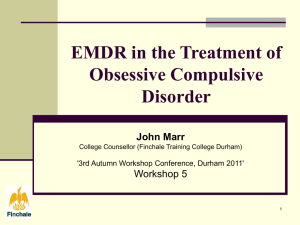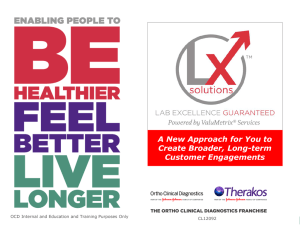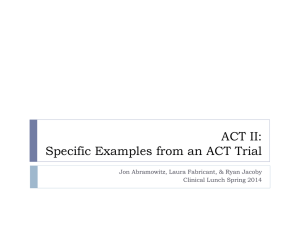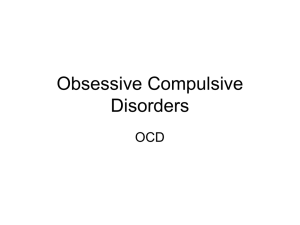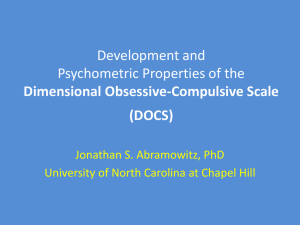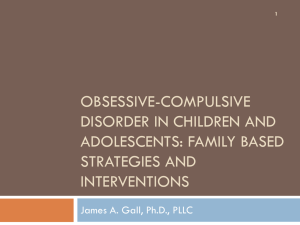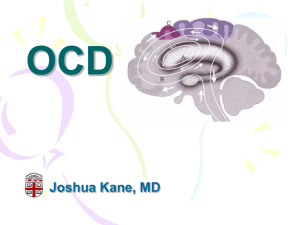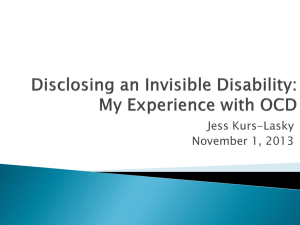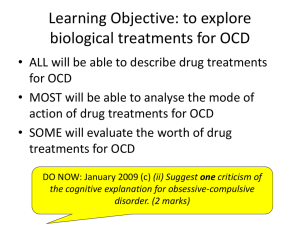507 Childhood OCD - University Psychiatry
advertisement
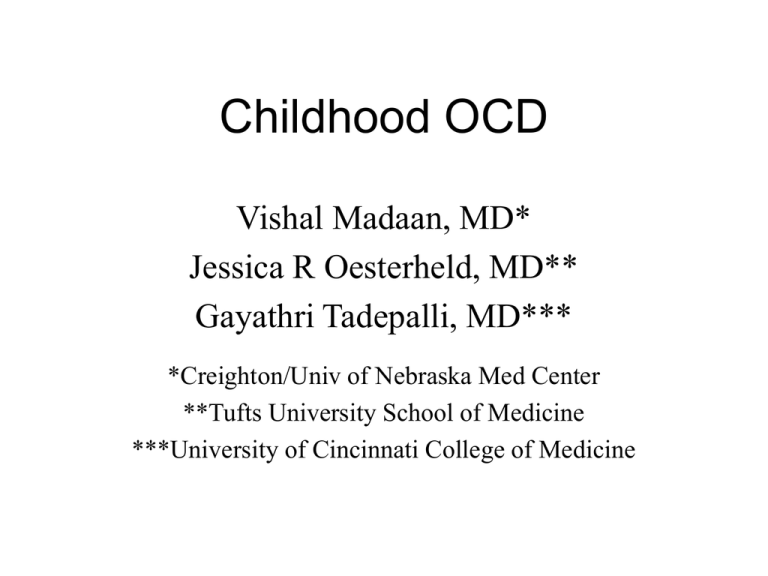
Childhood OCD Vishal Madaan, MD* Jessica R Oesterheld, MD** Gayathri Tadepalli, MD*** *Creighton/Univ of Nebraska Med Center **Tufts University School of Medicine ***University of Cincinnati College of Medicine Question 1 Early onset OCD is characterized by: A) Increased comorbid tic disorders B) Decreased comorbid ADHD C) Onset of OCD precedes tics by many years D) Minimal genetic loading Question 2 Common comorbid diagnoses with OCD include all of the following except: A) ADHD and ODD B) Major depression and anxiety C) Somatoform disorders D) Motor tics Question 3 The following medications are effective in the treatment of OCD, except: A) Clomipramine B) Fluoxetine C) Desipramine D) Fluvoxamine Question 4 The POTS trial in OCD found that the greatest reduction in CYBOCS scores results from: A) Sertraline alone B) CBT alone C) Combined CBT+Sertraline D) Family Therapy Question 5 Criteria for diagnosing PANDAS include: A) Motor and vocal tics B) Obsessive and compulsive disorder of childhood onset C) Tourette Disorder D) Sudden onset of OCD after a streptococcal infection Teaching Points • Distinguish between normal rituals vs. OCD; young children may not recognize their rituals as unreasonable or excessive • Commonest obsessions: Concerns regarding contamination, self harm, doing the right thing (scrupulosity), reassurance or sexual thoughts • SSRI+CBT may be the most efficacious treatment choice • Look for PANDAS Outline • • • • • • • • • OCD vs. normal childhood rituals DSM-IV criteria OCD epidemiology and symptomatology Comorbidity of OCD Assessment of OCD Course of OCD Treatment options: CBT & Pharmacotherapy The POTS study Special issues: PANDAS OCD vs. Normal rituals • Obsessions: “Persistent thoughts, images or impulses that are ego-dystonic & intrusive • Compulsions: Repetitive, purposeful behaviors in response to an obsession, usually to relieve anxiety • Compared to adults, youth may hide their rituals & can be secretive about them • Young children may not recognize their rituals as unreasonable or excessive; Important for clinician to help recognize associated impairment OCD vs. Normal rituals • Normal developmental rituals may include avoiding stepping on cracks in sidewalks (rituals related to belief in power of wishing) & normal collecting behaviors including baseball cards • Must distinguish vernacular “obsessive” and “compulsive” from clinical syndrome • Look for severity of behaviors and functional impairment DSM-IV criteria A) Presence of either obsessions or compulsions Obsessions: 1) Recurrent and persistent thoughts, impulses, or images that are experienced as intrusive and inappropriate and that cause marked worry or distress 2) Not simply excessive worries about real-life problems 3) Attempts to ignore or suppress them or neutralize them with some other thought or action. 4) Recognize they are a problem of ones own mind and not imposed from without (not children) Compulsions: 1) Repetitive behaviors (hand washing, ordering, checking or mental acts (praying, counting, repeating words) one is driven to perform 2) Behaviors ward off distress or prevent dreaded situation (not children) DSM-IV criteria B) Is recognized as excessive or unreasonable (not children) C) More than 1 hr a day or interfere with normal routine D) Not part of another Axis 1 condition E) Not caused by a substance or general medical condition Common symptoms • Excessive worries about danger, separation & contamination→ rituals of checking, hoarding & checking • Commonest obsessions: Concerns regarding contamination, self harm, doing the right thing (scrupulosity), reassurance or sexual thoughts • Common compulsions: Washing, repeating, checking, counting, touching, arranging and hoarding • Obsessions are more age dependent Symptoms of Childhood OCD • • • • Obsessive thoughts and washing- some times in 85% Repeating rituals in 50%:need to be perfect Checking in 46% (e.g., doors, windows, appliances) Ordering, arranging and symmetry in 17%, Scrupulosity in 13% • Takes 4-6 months before parents aware of sxs, secretiveness leads to long time before diagnosis (Leonard 1993) • In teens, sexual and religious obsessions especially preintimacy (Scahill et al 2003) • Symptoms shift over time (Rettew et al 1992) Epidemiology • Point prevalence 0.8%; lifetime prevalence 1.9% • Boys more likely with prepubertal onset; girls with pubertal onset • Male female ratio equalizes in adolescence • Early onset OCD: ↑ tic disorders; ↑ comorbid ADHD; onset of tics often precedes OCD by many years • Early onset OCD: Associated with stronger genetic loading • One-third to one-half adults with OCD have childhood onset Etiology • Genetic transmission- Twin studies show ‘genetic influences’: 45-65% (van Grootheest et al 2005) • Higher rates of OCD in 1° relatives (Nestadt et al 2000); 30% of adolescents had 1° relatives with OCD (Lenane 1990) • Areas of brain implicated: Basal ganglia • Increase size of caudate nuclei (Calabrese 1993) • Functional deficits in cortico-striato-thalamo-cortical circuit underlie OCD • Neurochemicals implicated: Serotonin Etiology • Hormonal dysregulation: Implicated as male/female ratio is 7:1 before age 10 years & 1:1.5 after puberty • Pediatric Autoimmune Neuropsychiatric Disorders Associated with Streptococcal Infections (PANDAS) subgroup: Post streptococcal production of auto-antibodies which cross-react with cellular components of basal ganglia Differential Diagnosis (Leonard et al 2006) • • • • • Depression and Anxiety disorders Eating disorders Tic disorders Body dysmorphic disorder Normal childhood rituals Comorbidity • Sole diagnosis (26%) • Major depression (26% ) • Anxiety disorders: Simple phobia (17%), SAD (7%), Overanxious disorder (16%) • Motor tics (30%) may have younger age of onset • Reading and language delays (24%) • ODD (11%), more in preadolescent boys • ADHD (10%)--but 30% in preadolescent boys (Swedo 1989) Assessment • • • • • • Use multiple sources of information Look for comorbidities Estimate extent of impairment Review developmental and family history Look for possible medical causes Utilize instruments such as Children's Yale-Brown Obsessive Compulsive Scale (CYBOCS) (http://www.bpchildresearch.org/grand/grand_rounds.cfm?ID= 24&page=YBOCS) Assessment: Instruments (Merlo et al 2005) • Semi structured interviews (e.g. Anxiety Disorders Interview for Children): Clinician administered with parents and children interviewed separately for 45-60 mins or K-SADS with one of five subscales • Child's Leyton Obsessional Inventory: Cards sorted 3 times for type, resistance and interference (Berg 1988) • Drug sensitive Scales: C-YBOCS, NIMH OC scale (Goodman 1992) Children’s Yale Brown Obsessive Compulsive Scale (CYBOCS) • Checklist of symptoms and 10 item clinician-driven questionnaire with 4 degrees of severity- 2 subscales Obsessions (20 points) and Compulsions (20 points)= 40 points; Integrate parent, child & clinician observations • Total 0-7 subclinical • Total 8-15 mild *10=remission • Total 16-23 moderate • Total 24-31 severe • Total 32-40 extreme • Good interrater reliability (Yucclen et al 2006) Assessing response using CYBOCS • CY-BOCS not extremely sensitive to change at highest severity • A 25% or 35% decrease is generally taken as efficacy and a score of 10 indicates full remission Childhood OCD with and without tics: Are there differences? • Patients with OCD & comorbid tic disorder: Higher rates of symmetry, touching, rubbing, staring, blinking (Leckman 1994) • Patients with OCD alone have more contamination and cleaning • OCD comorbid with tics more familial, more common in boys and has early onset (Geller 2001) OCD with comorbid ADHD • In a survey of youth with OCD, 25% patients had co-morbid ADHD (Masi et al 2006) • Comorbid ADHD can compromise school performance (Geller et al 2003); concentrating on school and homework common problems (Piacentini et al 2003) • More problems in social functioning, school and depression (Sukhodolsky et al 2005) • ADHD+ OCD: Higher rate in males, an earlier onset of OCD, a greater psychosocial impairment, and a stronger co-morbidity with bipolar disorder, tic disorder, and oppositional defiant disorder/conduct disorder (Masi et al 2006) Prognosis and long term outcome Meta-analysis by Steward 2003: 16 samples, n=521 children & adolescents with OCD: followed for 1-15 yrs Pooled data: 41% had full OCD at follow-up, 60% full or sub-threshold OCD Predictors of full OCD: Early age of onset, ↑ OCD duration & being inpatient; Comorbid psychiatric illness & poor initial treatment response were poor prognostic factors Long term medication studies: Modest incremental improvement but not normalization over 52 weeks of SSRI treatment; relapse rate after SSRI discontinuation possibly high Pharmacotherapy • FDA approval for youth: Clomipramine >10 yrs Fluoxetine >8 yrs Fluvoxamine >8 yrs Sertraline >6 yrs • Need 10-12 weeks at highest tolerated doses • 30-40% reduction in OCD symptoms with pharmacotherapy alone • Black Box warning for suicidality for all antidepressants in youth, regardless of disorder being treated Pharmacotherapy: Important points • All SSRIs appear equally effective • Choice made on side effects, pharmacokinetic profiles and drug interactions • Check for sexual side effects and check growth • Go slow with upward titration • 12 months of treatment better than 6 months • Slow taper when discontinuing Childhood OCD: Meta-analysis Meta-analysis of all DBPC medication trials in pediatric OCD including paroxetine (Geller et al 2003) 12 studies met inclusion criteria: 1044 children included; 8-12 weeks of treatment Overall effect size of 0.46 (modest effect) Clomipramine superior to each SSRI (which were indistinguishable from each other); this may however have resulted from its use (as the first such medication available) in non-refractory population Clomipramine • First medication to be studied for OCD • 3 studies support efficacy: – Flament et al 1985, 10wk DB cross-over of 23 youth 3mg/kg – DeVeaugh-Geis et al 1992 led to FDA approval – Leonard et al 1989 DB crossover between CMI 93-5mg/kg/dy and DMI • Ask about sudden death in first-degree relatives • In youth, CBC, LFTs, creatinine, EKG, BP and HR • Start at 25mg and gradually increase by 25 mg every 1014 days, get EKGs and at least one plasma level of CMI and desmethylCMI before next level and aim for 3mg/kg/day but not higher than 5mg/kg/day. • Watch for anticholinergic, seizures, blood pressure and heart rate changes Treatment Resistant OCD in Youth (Reinblatt and Walkup 2005) • If partial response, add CBT • Switch SSRIs • Augmentation with atypical antipsychotics, esp risperidone with schizotypy and tics • Augmentation with Clomipramine, Buspirone, Li, Pindolol, another SSRI or SNRI, clonazepam • SSRI and Clomipramine • Psychosurgery Cognitive Behavioral Therapy • Hierarchy-based Exposure and Response Prevention (March 1994, Scahill 1996, Franklin 1998): 14 sessions over 12 wks with toolkit approach, self-monitoring, mindfulness (‘watch the Obsessions or Compulsions doing their own thing, not belonging to me’)- use of “fear” thermometer • Imaginal exposure for obsessions: in vivo • Habit reversal for “just-so” phenomena • Cognitive restructuring for negative thoughts • Self observation, extinction, operant conditioning, and modeling used in adolescence: Behavioral rewards • Flooding, graded exposure, and response prevention (March et al 1994) • Family and group forms of treatment are effective as well (Barrett et al 2004) Pediatric OCD Treatment Study (POTS) • Compared efficacy of 4 different treatment options: Sertraline alone, sertraline +CBT, CBT alone & placebo alone; n=112; 12 weeks • Randomized parallel groups • Entry criteria CYBOCS=16; Mean of 24.6 with only ADHD meds allowed • Sertraline- Upward titration from 25→200 mg/d over 6 weeks • Outcome measure of remission: CYBOCS <10 POTS (Team POTS,JAMA 2004) POTS (Team POTS,JAMA 2004) POTS (Team POTS,JAMA 2004) POTS (Team POTS,JAMA 2004) POTS: Outcome • Mean daily dose of sertraline With combined treatment:133 mg/day Sertraline alone: 176 mg/day • Effect sizes: CBT: 0.97 Sertaline alone: 0.67 Combined treatment:1.4 • Remission rates (CYBOCS=10) for combined 53.6%; CBT alone 39.3%; sertraline 21.4% and placebo 3.6% Pediatric Autoimmune Neuropsychiatric Disorders associated with Streptococcal infections (PANDAS) • Five clinical criteria of the PANDAS subgroup: – Presence of OCD and/or tic disorder (using DSM-IV criteria) – Prepubertal symptom onset – Episodic course characterized by acute, severe onset and dramatic symptom exacerbations – Neurological abnormalities present during symptom exacerbations – Temporal relationship between GABHS infections & symptom exacerbations Treatment Guidelines for PANDAS (Swedo et al, 1998) • Assess for GABHS infection by 48 hour culture in child with abrupt onset OCD/Tic D/O. Treat positive culture with 10-day course of antibiotics • If abrupt onset of OCD/tics occurred 4-6 weeks before visit→ Check ASO & Anti-Dnase-B + 48 hr GABHS throat culture→ Do not treat with antibiotics if culture is negative (despite ↑ titers) • Obtain throat cultures at the time of relapse of OCD symptoms • Immunomodulatory treatment (Plasma exchange or IVIG) only used for most severely affected patients Refutation of PANDAS hypothesis (Kurlan and Kaplan 2004) (1) Level of severity of tics and OCD symptoms not defined (2) Age of onset the same as ‘regular’ TS and OCD. Further, there has been a post pubertal case reported (3) Abrupt onset not clinically specific since tics may not be identified gradually e.g. at least 2 studies show 38-50% of children with TS described as acute onset with no diagnosis of PANDAS (4) Does presence of choreiform movement suggest that diagnosis is Sydenham's? (5) GABHS as causative agent hard to show since a) carrier states b) infection worsens any tics. There is imprecision in the temporal course of PANDAS Clinical implications: PANDAS (Kurlan and Kaplan 2004) • Only get Streptococcal culture when there are clinical signs and symptoms (otherwise carrier state can be confusing) • Antineuronal antibodies and D8/17 are NOT reliable indicators (even though elevated D8/17 on B lymphocytes is a susceptibility marker for Rh-F) • Do not use prophylactic antibiotics and do not use plasma exchange and IV immunoglobulin Question 1 Early onset OCD is characterized by: A) Increased comorbid tic disorders B) Decreased comorbid ADHD C) Onset of OCD precedes tics by many years D) Minimal genetic loading Question 2 Common comorbid diagnoses with OCD include all of the following except: A) ADHD and ODD B) Major depression and anxiety C) Somatoform disorders D) Motor tics Question 3 The following medications are effective in the treatment of OCD, except: A) Clomipramine B) Fluoxetine C) Desipramine D) Fluvoxamine Question 4 The POTS trial in OCD found that the greatest reduction in CYBOCS scores results from: A) Sertraline alone B) CBT alone C) Combined CBT+Sertraline D) Family Therapy Question 5 Criteria for diagnosing PANDAS include: A) Motor and vocal tics B) Obsessive and compulsive disorder of childhood onset C) Tourette Disorder D) Sudden onset of OCD after a streptococcal infection Answers 1) A 2) C 3) C 4) C 5) D

